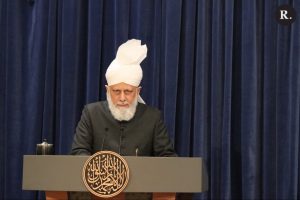
Wragge made many significant contributions to the field of meteorology, but his most important inquiry was into the truth of the Messiah (as).
Fazal Masood Malik, PEI, Canada
‘I have travelled the world but have never met a Prophet…’ [1] exclaimed Clement Wragge. He was on a lecturing tour in India when he met with the missionary of the Ahmadiyya Muslim Community, Mufti Sadiq (ra), who introduced him to the Promised Messiah (as). As a result, on May 12, 1908, Wragge held an audience with the Promised Messiah (as) in Lahore. ‘I am a man of science and seek facts only,’ said he.
The Promised Messiah (as) did not disappoint him.
Clement Wragge was a man of many hats and moods that swung like the storms that he chased all his life. But when he met with the Promised Messiah (as), his being was calmer than the deepest ocean. His inquisitive mind was satisfied and his soul at ease. A week later, he returned with his wife, Louisa, and his son, Kismet, for another discussion. The wealth of knowledge bestowed upon him by the Promised Messiah (as) is reason enough for us to thank this fiery, red-headed man, whose face was tanned by the sun of the open seas, and whose heart accepted Ahmadiyyat as the true Islam. [2]
Clement Lindley Wragge was born on 18 September 1852 at Stourbridge, Worcestershire, England. While he did not start out a meteorologist, he had an amazing career in it. He was orphaned during infancy and cared for by his grandmother, who instilled in him the love of science. As they lived in their own country house with plenty of nature to explore nearby, his passion for nature grew and ultimately became essential to who he was. While young Wragge wanted to follow in his father’s footsteps and become a solicitor, the call of science proved too strong. After spending years studying to be a lawyer, he embarked on a journey to visit many exotic lands, including Palestine, Egypt and Jerusalem. He did not return to England, arriving finally on Australian shores with an ambition only matched by his curiosity. Wragge never finished his law degree, allowing the love for science to come together with his passion for exploring the infinite questions on storms and their nature. In 1876 he joined the South Australian surveyor-general’s department, studying rainfall and climatology inland and its effect on larger rivers. [3]
He also met his first wife, Leonore Wragge, in Australia. Together, they would have nine children. [4] In 1878, they returned to Scotland, where Wragge continued his work in meteorology. In 1881, he undertook a task that would establish a weather observatory on Ben Nevis.
Standing at 4,409 feet above sea level, Ben Nevis is the highest mountain plateau in the United Kingdom. It sits directly in the path of the Atlantic storms, making it an ideal location for studying meteorological changes at higher altitudes and the formation of storms. The Scottish Meteorological Society had tried, rather unsuccessfully, to raise funds for a permanent observatory at this location. Failing to make a conclusive argument to secure the funding they needed, they sought assistance from Clement Wragge, a citizen scientist.
Mr. Wragge volunteered to make necessary observations, climbing the mountain every day from June to October 1881, a journey of 22.5 kilometres round trip from the base at sea level. His wife, Leonora, made comparable observations at sea level at Fort William at the same time. He repeated this task in all sorts of weather in the two years that followed, even though there was no shelter where one could hide safely from the elements. He would have to be at the station at 9:00 am every morning, sometimes hiding under rocks to avoid the hail, at other times walking through deep snow to get to the instruments. He received a Gold Medal from the Scottish Meteorological Society for his outstanding work at Ben Nevis.
The work done by Wragge was significant in understanding the storms that came in over the Atlantic. This work helped scientists understand their formation, severity, and trajectory. Today, those studies are being revived by modern-day scientists to study climate change in the 21st century. The permanent observatory formed at Ben Nevis and based on his work was a source of pride for him. [5]
Returning to Australia, he established several observatories in Torrens, Adelaide, Mount Lofty, Mount Wellington, Tasmania and Mount Kosciusko, the highest peak in Australia. His efforts to collect accurate data from all points of Australasia are no less than remarkable. [6] At one point, he established communication with the captains of ships arriving and departing to Australian ports, politely requesting them to gather weather-related data as they traversed the open seas. Australia’s remote location and the lack of cable communication to report current data from points outside of the mainland meant that he had to rely on past information to calculate future weather. [7]
Having established numerous weather stations at critical points on the continent, he had started publishing inter-colonial weather forecasts in newspapers. By 1891, his work was so highly regarded that he was the Queensland’s (Australian) delegate to the International Meteorological Conference in Munich, [8] a role he repeated in 1896 in Paris. [9]
Using his extensive network of weather stations, he was able to predict the storms that would make landfall and even those which remained at sea. It became evident to him that a standard naming convention had to be used to track cyclones and low-pressure systems. In the last decade of the 19th century, he introduced a method of systematically naming weather disturbances. This enabled the government to take the necessary actions, saving countless lives on land and the sea. Clement Wragge thus became the first person to initiate a storm naming convention, [10] a practice that was picked up in North America 80 years later!
By the time the Australian Commonwealth Meteorological Bureau was established in 1906, he had brought a high degree of accuracy to long-term weather forecasting, a monumental task and one that Australians sincerely appreciated. And so, it was unsurprising that he was bitterly disappointed when he was passed over for an appointment as the head of the bureau, especially since he had advocated for it extensively. In protest, he left Australia. [11] It was a bitter-sweet departure that changed his life. He travelled to England, Ceylon, Fiji and India, lecturing ‘on the marvels of the universe.’ [12]
At the same time, his personal life suffered turmoil. Clement and Leonora’s marriage became estranged sometime before 1900. His second marriage was to Louisa Emmeline (Edris) Wragge, from Karachi, India. His youngest son, Kismet, was from Louisa and was born in 1900. [13] Louisa and Kismet accompanied Clement for his second meeting with the Promised Messiah (as) on May 18, 1908.
His arrival in India at this most fortunate time is nothing short of a miracle. He was lecturing in Lahore in May of 1908, shortly before the demise of the Promised Messiah (as). Throughout his long years, he had not stopped wondering, in his words, whether the ‘Jewish God was the God of an infinite universe.’ After a lecture that was attended by many intellectuals and a slideshow conducted using a lantern, a discussion with Mufti Sadiq (ra) made him curious to learn more. He was interested in religion and he was restless to meet the Prophet, for whom he had ‘searched his entire life.’
The two meetings with the Promised Messiah (as) in Lahore changed his being. His outlook on life, towards science, towards existence, changed. ‘At back of and in everything, then, God IS; everything that is, has been, or ever can be is an oozing forth from the Absolute or “God,” just as a ray of sunlight comes from the Sun.’ [14] In the course of their discussion, Wragge and the Promised Messiah (as) discussed a wide range of topics, from spirituality to science. Later he became an Ahmadi Muslim and remained so till his last breath, communicating regularly with Mufti Sadiq (ra). [15]
Eventually, he returned to the South Pacific and settled in Auckland, New Zealand. His love for nature and archeology began to emerge and complement his love of the weather. His garden was unlike any other. Instead of neatly arranged rows of plants, it was a wild tropical jungle of species from all over the world. He carefully tended to each one, nurturing them like his own children. And in turn, they rewarded him with their beauty and bounty.
On one of his many travels, he found evidence of an ancient civilisation in the neighbourhood of the Bay of Islands. Here, he discovered fascinating rocks and landmarks that told an impressive story of a civilization long before the Maori [16] – A testament to the Holy Quran, which states, ‘Travel in the earth and see how was the end of those before you…’ (30:43)
His love for meteorology lasted for the rest of his life. Even in his late age, he could be found in his office, deep in thought, scribbling over maps and drawings of cyclones and anti-cyclones.
In 1922, he passed away in Auckland. His son, Kismet, took over the long-term forecasting, contributing positively towards the science that we take for granted today. Clement Lindley Wragge was a genius, a man of many talents. ‘If I were to give my whole time to meteorology,’ he had expressed in 1893 to a reporter, ‘I should become too one-sided.’ During his lifetime, he established numerous weather observation stations and museums housing exotic displays from Jerusalem, Fiji and other far-off lands that most people then could only dream of ever visiting. [17] His ethnography, geology, and natural history collection was donated to the City of Stafford, England. He also made a venture into rain-making with the Steiger Vortex Gun. [18]
While Wragge had a varied and remarkable career, his open-mindedness and opportunity to meet and discuss religion and science with the Messiah of the time was even more remarkable. And in fact, in 2006, the Caliph of the Promised Messiah (as), Hazrat Mirza Masroor Ahmad (aba), prayed at the grave of Clement Wragge on the auspicious occasion of his visit to New Zealand. This was a blessed visit that the esteemed meteorologist could not have forecasted. [19]
About the Author: Fazal Masood Malik is an avid educator of Islamic values in contemporary society. He has travelled extensively in Atlantic Canada and the Prairies, educating people about Islam. His biography of the Promised Messiah (as) is currently under publication review. His articles have appeared in various publications, such as Kindly Heretics (a biographyof Ahmadi Muslims worldwide).
ENDNOTES
1. Hazrat Mufti Muhammad Sadiq (ra). ‘A Discussion between an Englishman and the Promised Messiah [Urdu]’. In: Zikr-e-Habib, p.329.
2. Hazrat Mirza Ghulam Ahmad (as), “A Discussion with Professor Wragge of England,” Malfuzat, Vol. 5. (Nazarat Isha’at Rabwah Pakistan: 1988), pp.618-626. For discussion on acceptance of Islam, please see Sadiq (ra) Zikr-e-Habib, pp. 328-9.
3. Clement L.Wragge, “Reminiscence of an eventful life,” (Australian) Bulletin, vol 42, No. 2179. Nov 17, 1921. p.48.
4. Clement L. Wragge, “Clement Wragge – Historical records and family trees”, www.myheritage.com, accessed February 20, 2022.
5. Ben Nevis, it’s location and significance has been discussed extensively in numerous articles. For details see (in order) A. Buchan, “The Meteorology of Ben Nevis.” Nature (August 7 1884). pp. 336-7. For extensive discussion of contributions made by Wragge, see Majory Roy, The Weathermen of Ben Nevis: 1883-1904. (Royal Meteorological Society, 2004). Also James Paton, “Ben Nevis Observatory 1883–1904.” Weather 9, no. 10 (1954): 291-308.
6. Jack Thwaites, “Clement Wragge’s Observatory on Mt. Wellington.” The Tasmanian Tramp No. 24 (1982-1983). C. I. Richmond & Sons. 1983. Also Jensen, H. I. D. Sc. “A Winter on Mount Kosciusko.” The Lone Hand (The Australian Monthly) Vol. 5 No. 26 (Jun 1, 1909), https://nla.gov.au:443/tarkine/nla.obj-402007884 Accessed online Feb 16, 2022.
7. See entry on “Wragge, Clement Lindley (1852–1922)” https://adb.anu.edu.au/biography/wragge-clement-lindley-9193 accessed November 2, 2021.
8. George James Symons, Symons’s Monthly Meteorological Magazine. Vol. 26. Edward Stanford, (1891). pp. 180-1.
9. A. Lawrence Rotch, “The International Meteorological Conference at Paris, September, 1896.” Monthly Weather Review 24, no. 10 (1896): 365-367.
10. Chrystopher J. Spicer, Cyclone Country: The Language of Place and Disaster in Australian Literature (McFarland: 2020). Also see E.B. Buxton, “Tropical Disturbance Eline [sic]. 1898,” Weatherwise, 23, (1970): pp. 222-223, 255.
11. Clement Wragge, ‘Science of Man.’ Oct 3, 1911. Romance of Romances: Ancient South Sea Civilisations. pp. 122-123. Also see The Evening Post (NZ). Mar 7, 1910. p. 7.
12. Clement L.Wragge, “Reminiscence of an eventful life,” (Australian) Bulletin, vol 42, No. 2179 (Nov 17, 1921) – p.48.
13. Clement L.Wragge, “Clement Wragge – Historical records and family trees”, www.myheritage.com, accessed February 20, 2022. Also, see A. Darbyshire, “The first two residents, Clement Lindley Wragge and Thomas James Rothwell.”, St. Lucia History Group Research Notes 36.
14. Clement L.Wragge, Endless Universe and Eternal Life (Auckland: Arthur Cleave & Co., 1921), 4.
15. Hazrat Mufti Muhammad Sadiq (ra). ‘A Discussion between an Englishman and the Promised Messiah’ [Urdu]. In: Zikr-e-Habib, p.341 and Hazrat Mirza Masroor Ahmad (aba), Friday Sermon “Tour of the Far East and Oceania.” May 19, 2006.
16. “Sermons in Stones.”, Evening Post (NZ), vol LXXIX, Issue 55, 7 March 1910. Also “Mr Clement L. Wragge’s discovery.”, North Otago Times (Auckland), 5 (April 1910): p. 4.
17. S.M. Herald, “Mr. Wragge Interviewed.” Northern Star (Australian daily). Mar 8, 1893.
18. G. Parwell, “How we Broke the Drought, Almost,” Reader’s Digest, August, 1973. Accessed Feb 20, 2022. https:// www.pressreader.com/australia/readers-digest-asia-pacif ic/20210101/281539408522935. Named after its inventor, Albert Steiger, the Steiger Vortex gun is a rainmaking device with a cone-shaped barrel made of sheet steel. It was first created as means to stop catastrophic hailstorms in an Austrian wine-growing region. When fired into clouds, a gas discharge sets off vibrations in the clouds, resulting in rain. Clement Wragge, concerned about the prolonged drought in the Queensland, theorised using this invention to bring much needed rain. The results were mediocre and on second attempt, two of the guns exploded, thus ending the experiment.
19. Hazrat Mirza Masroor Ahmad (aba), Friday Sermon “Tour of the Far East and Oceania.” May 19, 2006.




Add Comment